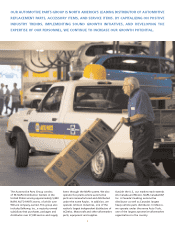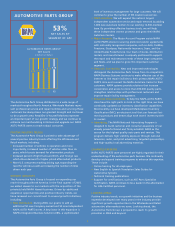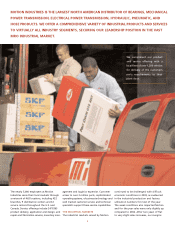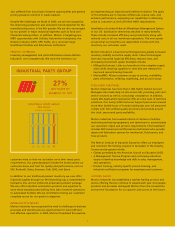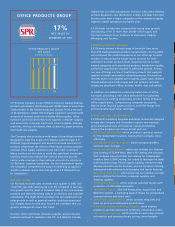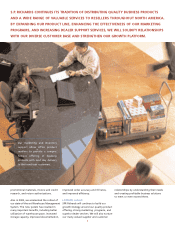Napa Auto Parts 2003 Annual Report Download - page 16
Download and view the complete annual report
Please find page 16 of the 2003 Napa Auto Parts annual report below. You can navigate through the pages in the report by either clicking on the pages listed below, or by using the keyword search tool below to find specific information within the annual report.
14
$2.1 billion were 24.3% of sales compared to 23.6% last year.
The decrease in cost of goods sold and the increase in expenses
reflect our reclassification of certain vendor consideration
associated with the adoption of EITF 02-16, as defined below.
Before the reclassification, cost of goods sold in 2003 was
70.2% of sales and SG&A expenses were 23.1% of sales. The
comparable increase in cost of goods sold was due to lower
levels of vendor discounts and volume incentives related to
purchases, overall competitive pricing pressures and product
and customer mix. The comparable decrease in SG&A expens-
es reflect our on-going cost savings initiatives, such as tight
operating expense controls and facility consolidations.
Effective January 1, 2003, the Company was required to adopt
the Financial Accounting Standards Board Emerging Issues Task
Force’s Issue No. 02-16, related to the accounting treatment
of cash consideration received from vendors (“EITF 02-16”).
This encompasses certain advertising and promotional
allowances, catalog support and other cash support arrange-
ments that normally exist among retailers and distributors
with their vendors. The Company historically classified certain
vendor monies received, primarily advertising related, as a
component of selling, administrative, and other expenses.
Under the new EITF 02-16, these vendor monies generally must
be classified as cost of goods sold and a portion of the amounts
must be capitalized into ending inventory. In connection
with the adoption of EITF 02-16, the Company recorded a
cumulative effect adjustment of approximately $19.5 million.
In addition, as a result of the January 1, 2003 adoption of
EITF 02-16, approximately $102.2 million was reclassified from
selling, administrative and other expenses to cost of goods
sold in the consolidated statement of income for the year
ended December 31, 2003. Under EITF 02-16, prior periods
were not reclassified.
Cost of goods sold was 69.1% of net sales in 2002 as compared to
69.3% in 2001. The decrease can be attributed to more efficient
supply chain costs and inventory mix. Selling, administrative, and
other expenses of $1.9 billion were flat as compared to 2001, and
slightly down from the previous year as a percentage of sales.
OPERATING PROFIT
Operating profit as a percentage of sales was 7.9% for 2003
compared to 8.5% in 2002. These results reflect our decrease
in gross margins before the reclassification of vendor consider-
ation as discussed above, rising pension and healthcare costs,
and the overall economic conditions in certain markets, which
have constrained our sales opportunities. Operating profit as
a percentage of sales was 8.5% for 2002, which was flat with
2001. These results reflect overall economic conditions, as
well as the fixed costs inherent in distribution, which have
continued to impact operating margins.
Automotive Group
Automotive operating margins decreased from 8.8% in 2002
to 8.1% in 2003, primarily due to pricing pressures combined
with increases in salaries, insurance, and other expenses
associated with the addition of new Company owned stores.
Automotive operating margins decreased slightly from 8.9% in
2001 to 8.8% in 2002. Costs associated with new store openings
were only partially offset by cost reductions associated with
distribution center closings and other headcount reductions.
Industrial Group
Industrial operating margins decreased from 7.9% in 2002 to
6.7% in 2003, as lower levels of vendor discounts and volume
incentives affected this segment the greatest. Industrial oper-
ating margins increased from 7.7% in 2001 to 7.9% in 2002,
reflecting cost and headcount reductions resulting from
branch closings.
Office Group
Operating margins in our Office Group decreased slightly
from 10.1% in 2002 to 9.8% in 2003, primarily attributable to
customer and product mix. Office Group margins decreased
slightly from 10.3% in 2001 to 10.1% in 2002.
Electrical Group
Operating margins in our Electrical Group increased from .9% in
2002 to 2.4% in 2003, as this Group continued to reduce costs
through headcount reductions, branch closings and operating
expense controls. Our Electrical segment increased their margins
slightly from .8% in 2001 to .9% in 2002.
INCOME TAXES
The effective income tax rate decreased from 39.3% to 38.2%
for the year primarily due to the utilization of foreign tax
credits in 2003. The effective income tax rate decreased from
40.1% in 2001 to 39.3% in 2002, primarily as a result of the
decrease in non-deductible goodwill amortization due to
the adoption of Statement of Financial Accounting Standards
No. 142, “Goodwill and Other Intangible Assets” (SFAS 142).
NET INCOME
Net income, before the cumulative effect of changes in
accounting principles, was $354 million compared to $368
million in 2002, a decrease of 4%. On a per share diluted
basis, net income for the period, before the cumulative effect
of changes in accounting principles, equaled $2.03 compared
to $2.10 reported in 2002. After the 2003 and 2002 cumulative
effect of changes in accounting principles, net income was
$334 million, or $1.91 diluted earnings per share for 2003, as
compared to the net loss in 2002 of $28 million, or $.16 diluted
loss per share. Net income, before the cumulative effect of
changes in accounting principles in 2003 and 2002, was 4.2%
of net sales compared to 4.5% in 2002.
In the first quarter of 2002, the Company completed impairment
testing for goodwill in conjunction with the new provisions
introduced in SFAS 142 resulting in a non-cash charge of
$395.1 million. This was recorded as of January 1, 2002 as a
cumulative effect of a change in accounting principle. Net
income, before the cumulative effect of a change in accounting
principle, was 4.5% of net sales as compared to 3.6% in 2001.
Net income for 2002, before the cumulative effect of a change
in accounting principle, was $368 million, an increase of 2%,
compared to $362 million, before the Facility Consolidation,
Impairment and Other Charges (“2001 Charges”) as discussed
MANAGEMENT’S DISCUSSION AND ANALYSIS OF FINANCIAL CONDITION AND RESULTS OF OPERATIONS
(continued)


